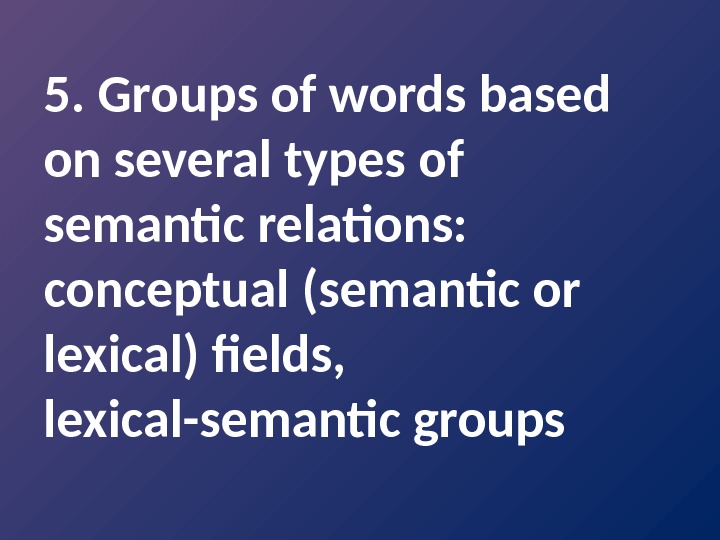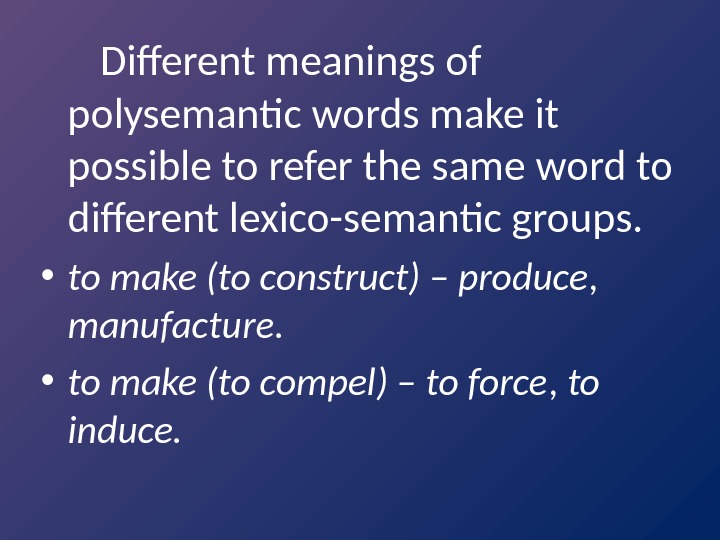4. Paradigmatic relations of inclusion (hierarchical relations): hyponymy,



















lekciya_5,_voprosy_4,_5.ppt
- Размер: 167.0 Кб
- Автор:
- Количество слайдов: 18
Описание презентации 4. Paradigmatic relations of inclusion (hierarchical relations): hyponymy, по слайдам
 4. Paradigmatic relations of inclusion (hierarchical relations): hyponymy, meronymy, serial relations
4. Paradigmatic relations of inclusion (hierarchical relations): hyponymy, meronymy, serial relations
 Hyponymy: a semantic relation of inclusion. • car , bus , taxi – vehicle; • oak , pine – tree; • horse , cow – animal.
Hyponymy: a semantic relation of inclusion. • car , bus , taxi – vehicle; • oak , pine – tree; • horse , cow – animal.
 The hyponymic relationship may be viewed as the hierarchical relationship between the meaning of the general and individual terms.
The hyponymic relationship may be viewed as the hierarchical relationship between the meaning of the general and individual terms.
 Plant grass bush tree shrub fower pine oak ash white pine yellow pine
Plant grass bush tree shrub fower pine oak ash white pine yellow pine
 The more specific term is called the hyponym. The more general term is called the hyperonym or the classifier.
The more specific term is called the hyponym. The more general term is called the hyperonym or the classifier.
 Meronymy: the relations of parts to the whole
Meronymy: the relations of parts to the whole
 The division of the human body into parts: Body Arm Hand Finger
The division of the human body into parts: Body Arm Hand Finger
 Serial relations: • graded (open-ended series) e. g. military ranks; an open number system as in one, two, three. . . • cyclical series (not open-ended series) e. g. seasons of the year; days of the week
Serial relations: • graded (open-ended series) e. g. military ranks; an open number system as in one, two, three. . . • cyclical series (not open-ended series) e. g. seasons of the year; days of the week
 5. Groups of words based on several types of semantic relations: conceptual (semantic or lexical) fields, lexical-semantic groups
5. Groups of words based on several types of semantic relations: conceptual (semantic or lexical) fields, lexical-semantic groups
 Words may be classified according to the concepts underlying their meaning.
Words may be classified according to the concepts underlying their meaning.
 Semantic Fields: closely knit sectors of vocabulary each characterized by a common concept.
Semantic Fields: closely knit sectors of vocabulary each characterized by a common concept.
 • blue, red, yellow, black – semantic field of color; • mother, father, brother – kinship terms.
• blue, red, yellow, black – semantic field of color; • mother, father, brother – kinship terms.
 We cannot possibly know the meaning of the word if we do not know the structure of the semantic field to which the word belongs.
We cannot possibly know the meaning of the word if we do not know the structure of the semantic field to which the word belongs.
 The meaning of captain • cannot be properly understood until we know the semantic field in which this term operates – the navy, the army or merchant service: we know what captain means only if we know if his subordinate is called mate or first officer (merchant service), commander (navy), lieutenant (army).
The meaning of captain • cannot be properly understood until we know the semantic field in which this term operates – the navy, the army or merchant service: we know what captain means only if we know if his subordinate is called mate or first officer (merchant service), commander (navy), lieutenant (army).
 Words making up semantic fields may belong to different parts of speech. • space – nouns: expanse, extent, surface ; verbs: extend, spread, span ; adjectives: roomy, vast, broad.
Words making up semantic fields may belong to different parts of speech. • space – nouns: expanse, extent, surface ; verbs: extend, spread, span ; adjectives: roomy, vast, broad.
 There may be comparatively small lexical groups of words belonging to the same part of speech and linked by a common concept. • concept of food – bread, cheese, milk.
There may be comparatively small lexical groups of words belonging to the same part of speech and linked by a common concept. • concept of food – bread, cheese, milk.
 Lexico-semantic Groups: smaller lexical groups consisting of words of the same part of speech.
Lexico-semantic Groups: smaller lexical groups consisting of words of the same part of speech.
 Different meanings of polysemantic words make it possible to refer the same word to different lexico-semantic groups. • to make (to construct) – produce , manufacture. • to make (to compel) – to force , to induce.
Different meanings of polysemantic words make it possible to refer the same word to different lexico-semantic groups. • to make (to construct) – produce , manufacture. • to make (to compel) – to force , to induce.

